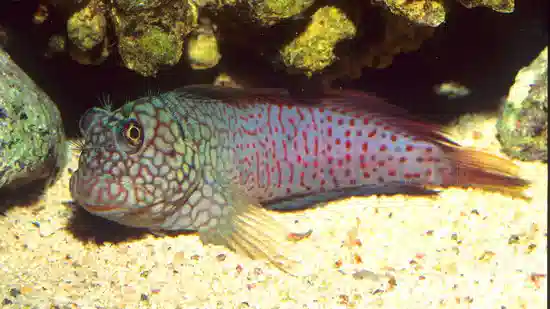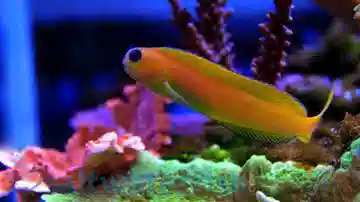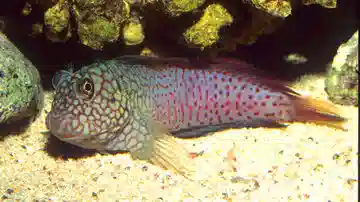Ember Blenny
Cirripectes stigmaticus
(0 Reviews)

Ember Blenny
Cirripectes stigmaticus
(0 Reviews)
{{ item.name }}
Size: {{ item.extra_field_3 }}
${{ getFormattedPrice(item.saleprice) }} ${{ getFormattedPrice(item.price) }}
To join the waiting list, click here
Free Shipping
With
$199.00
or more in Marine Life.
More details...
Ember Blenny Care Facts
| Care Level: | Moderate |
|---|---|
| Temperament: | Peaceful |
| Diet: | Omnivore |
| Origin: | Indo-Pacific Ocean |
| Acclimation Time: | 2+ hours |
| Reef Safe: | Yes |
| Minimum Tank Size: | 55 gallons |
| Max Size: | 6 inches |
The Ember Blenny (Cirripectes stigmaticus) can be found among the reefs of the Indo-Pacific Ocean searching for algae or small invertebrates to feed on. They have black or brown bodies with deep red colorations, providing their other common names: Red-Streaked or Scarlet Spotted Blennies. They require a minimum of 55 gallons, as well as plenty of rocks to hide among or perch upon. They should be fed a mixed diet of algae and carnivorous frozen foods, such as mysis or krill, and should be kept with other fish of similar size and temperament.
Ember Blenny (Cirripectes stigmaticus): A Captivating Addition to Your Marine Aquarium
The Ember Blenny, scientifically known as Cirripectes stigmaticus, is a fascinating and captivating addition to saltwater marine aquariums. This informative guide will provide an in-depth overview of this species, covering topics such as their habitat, reef compatibility, size, lifespan, diet in captivity, availability for hobbyists, compatibility with other fish and invertebrates, sexual dimorphism, juvenile to adult coloration changes, temperament, tank requirements, and water conditions. We will also discuss common names for this species, compatible tank mates, and why you should consider acquiring Ember Blennies from Saltwaterfish.com.
Habitat: Exploring the Western Pacific Ocean
The Ember Blenny is predominantly found in the Western Pacific Ocean, inhabiting coral reefs and rocky shorelines. This species is known for its ability to adapt to various microhabitats within these regions. They often seek shelter in crevices and small caves, where they can dart in and out to forage for food and evade potential threats. Understanding their natural habitat is crucial for replicating their ideal living conditions in an aquarium.
Reef Compatibility of the Ember Blenny: A Reef-Safe Delight
Ember Blennies are generally considered reef-safe. They will not harm corals, anemones, or other invertebrates within your aquarium. They can benefit a reef environment by helping to control algae growth, particularly on live rock and substrate.
Size and Lifespan of the Ember Blenny: Small Marvels with Longevity
Ember Blennies are relatively small, typically reaching a maximum size of about 2.5 inches (6.3 cm) in length. Their lifespan in captivity can vary, but with proper care and a suitable environment, they can live for up to 4-6 years or more.
Diet in Captivity: Culinary Preferences of the Ember Blenny
In captivity, Ember Blennies are omnivorous and should be offered a varied diet. They readily accept high-quality flake and pellet foods, frozen or live offerings such as mysis shrimp, brine shrimp, and copepods. A diverse diet will help them receive the essential nutrients needed for their well-being.
Aquaculture and Availability: A Glimpse into Ember Blenny Acquisition
The Ember Blenny is occasionally available through aquaculture, which helps reduce the impact on wild populations. Availability may vary, so checking with reputable marine aquarium suppliers like Saltwaterfish.com for their current stock is advisable.
Compatibility with Other Fish and Invertebrates: Promoting Peace in Your Tank
Ember Blennies are generally peaceful and add diversity to community saltwater aquariums. They get along well with other small, non-aggressive fish species. They also coexist harmoniously with reef-safe invertebrates. However, as with all fish, it's essential to monitor interactions and ensure tankmates do not threaten the Ember Blenny.
Sexual Dimorphism: A Visual Challenge
Ember Blennies do not exhibit significant sexual dimorphism, which means it can be challenging to distinguish between males and females visually.
Juvenile to Adult Coloration Changes: A Symphony of Colors
Ember Blennies display captivating coloration changes as they mature. Juveniles typically have vibrant reddish-orange bodies with subtle black markings. As they grow, their coloration deepens and may become more intense, creating a striking visual impact in your aquarium.
Temperament: The Docile Nature of Ember Blennies
Ember Blennies are generally peaceful and non-aggressive, making them suitable for community aquariums. They are known for their inquisitive nature and can be quite active within the tank, darting in and out of hiding places while foraging for food.
Detailed Tank Requirements: Crafting a Haven for Ember Blenny
Minimum Aquarium Size: A tank with a minimum capacity of 20 gallons is suitable for a single Ember Blenny. However, if you plan to keep multiple specimens, consider a larger tank of at least 75 gallons is advisable.
Water Conditions:
- pH: Maintain a stable pH level within the range of 8.1 to 8.4 to ensure proper metabolic function.
- Salinity: Keep the salinity level consistent at 1.023-1.025 to mimic natural seawater conditions.
- Water Temperature: Keep the water temperature between 75°F to 82°F (24°C to 28°C).
- Water Flow: Moderate water flow within the tank is sufficient, simulating the gentle currents in their natural habitat.
Common Names: Recognizing the Ember Blenny
The Ember Blenny is also known by the following common names:
- Flame Blenny
- Flame-Tail Blenny
- Stigmatic Blenny
Five Compatible Tank Mates: Building a Harmonious Community
Firefish Goby (Nemateleotris magnifica): These colorful and peaceful gobies make excellent companions for Ember Blennies, as they share similar tank requirements and temperaments.
Royal Gramma (Gramma loreto): These small, vividly colored fish are known for their peaceful nature and adapt well to community aquariums.
Clownfish (Amphiprion sp.): Clownfish come in various species and colors and are generally peaceful tank mates that can coexist with Ember Blennies.
Neon Blue Goby (Elacatinus oceanops): This tiny, blue-colored goby is a peaceful fish that thrives in reef environments and can be an excellent companion for your Ember Blenny.
Cleaner Shrimp (Lysmata amboinensis): These invertebrates benefit your aquarium's overall health and can also cohabitate with Ember Blennies without issue.
Why Choose Ember Blennies from Saltwaterfish.com: A Trusted Source for Your Marine Pets
When considering where to source your Ember Blennies, Saltwaterfish.com is an ideal choice for several reasons:
- Quality Assurance: Saltwaterfish.com takes pride in offering high-quality marine livestock. Their selection is carefully curated to ensure the health and vitality of the animals they provide.
- Expert Advice: The team at Saltwaterfish.com includes experienced aquarists who can provide valuable guidance and support, ensuring the success of your Ember Blenny-keeping journey.
- Sustainable Practices: By choosing Saltwaterfish.com, you support responsible and sustainable aquaculture practices, helping to reduce the impact on wild populations.
- Wide Selection: Saltwaterfish.com offers a variety of marine species, including Ember Blennies, making it a one-stop destination for all your saltwater aquarium needs.
In Conclusion: Beauty and Serenity in Your Underwater World
In conclusion, the Ember Blenny (Cirripectes stigmaticus) is a captivating addition to saltwater marine aquariums. With its peaceful temperament, striking coloration, and reef-safe nature, it can bring beauty and intrigue to your tank. Following proper care guidelines and sourcing your Ember Blennies from reputable suppliers like Saltwaterfish.com, you can enjoy the beauty and serenity they bring to your underwater world.
Currently Ember Blenny does not have any reviews.














